Oak & Scots Pine
£20.00
Oak and Scots Pine (scroll down for a more detailed Description)
Published 1972 by © Hugh Evelyn Limited; drawn around 1525, these images were finished in gouache and watercolour (see description here)
Size: c. 23 x 33.5 cm [9 ″ x 13 ¼ ″] may vary slightly from printers’ cut 50 years ago
Printed on high white matt cardstock 144 g/sm2.
Print is STANDARD size – shipping is the same for 1 to 10 prints (based on largest print size in your order) – see Shipping & Returns.
In stock
Description
Oke: An oak is a tree or shrub in the genus Quercus (Latin “oak tree”) of the beech family, Fagaceae. There are approximately 600 extant species of oaks. The name Oak stems from the Anglo-Saxon œc. This, and similar sounding names in other languages (Scots aik; Swedish ek; German Eiche) refer to the acorn. They are etymologically identical with the word egg. In these languages Oak and egg either have the same name, or the names are switched perhaps due to the shape. The name Oak is so deeply rooted that there are no other popular names for the tree. It derives from its most useful product: from Anglo-Saxon times, Oak forests were valued for pannage – the fattening of hogs. The timber later came to be used for building houses and boats, the Hearts of Oak. Ultimately it was used to build the Royal Navy’s ships especially from the time of King Henry VIII until the age of steam. It made charcoal and Oak charcoal was used to smelt iron. The bark is used in tanning, and a decoction can be used for chronic diarrhoea and dysentery. Grated acorns sprinkled on food are an old remedy for diarrhoea. Roasted and ground they have been used as a coffee substitute. Arber (1) reproduces a woodcut of a Cork Oak (Quercus suber) from Mattioli’s (2) Commentarii. Pynapple: Scots pine (Pinus sylvestris) is a species of pine that is native to Eurasia, ranging from Western Europe to Eastern Siberia, south to the Caucasus Mountains and Anatolia, and north to well inside the Arctic Circle in Scandinavia. It is a native and was the dominant tree of much of the Highlands. It is thought most specimens in England were introduced, although some may be descendants of survivors from the post-glacial age 7000 years ago when it was dominant over much of Europe. The term pynappel was used for the cones, their superficial resemblance being to the tropical genus Ananas (Pineapple). The term is rarely applied today whilst the name Deal Apples was known in Suffolk. Pine trees form valuable windbreaks in flat exposed places like the East Anglian brecklands. The timber, known as deal, is useful. Some parts of this tree (sylvestris, which means wild, or uncultivated) and other Pines are used medicinally, including Pine Oil, for inhalations or externally as a rubefacient. Stockholm Tar, obtained by the destructive distillation of stems and roots of Pine trees, is antiseptic and expectorant, so is used for obstinate bronchial coughs and eczema.
Additional information
| Weight | 0.0094 kg |
|---|---|
| Dimensions | 24 × 33.7 cm |

 Caledonian Railway 4-4-0, No. 721 'Dunalastair'
Caledonian Railway 4-4-0, No. 721 'Dunalastair'  1929 Stutz 36.4
1929 Stutz 36.4  1904 De Dion Bouton
1904 De Dion Bouton  Great Northern of Scotland Railway 4-4-0, No. 81
Great Northern of Scotland Railway 4-4-0, No. 81  1930 Alfa-Romeo 17-95
1930 Alfa-Romeo 17-95  1917 Sopwith Camel
1917 Sopwith Camel  Town Coach
Town Coach  North Eastern Railway 1885
North Eastern Railway 1885  Albatros D.V 1917
Albatros D.V 1917  Circus
Circus  No. 52 Langbourn Ward Volunteer
No. 52 Langbourn Ward Volunteer  No. 53 St. George's Hanover Square Armed Association
No. 53 St. George's Hanover Square Armed Association  Bleriot XI, 1909
Bleriot XI, 1909  No. 54 St. Sepulchre Volunteers
No. 54 St. Sepulchre Volunteers  Landau
Landau  Travelling Coach or Stagecoach
Travelling Coach or Stagecoach  Great Eastern Railway, 1894
Great Eastern Railway, 1894  Sir William Marshal, 1st Earl of Pembroke, 1146-1219
Sir William Marshal, 1st Earl of Pembroke, 1146-1219  1879 Bayliss-Thomas 'Ordinary' Bicycle
1879 Bayliss-Thomas 'Ordinary' Bicycle  Montacute House, Somerset
Montacute House, Somerset  Royal Aircraft Factory S.E.5, 1917
Royal Aircraft Factory S.E.5, 1917 



